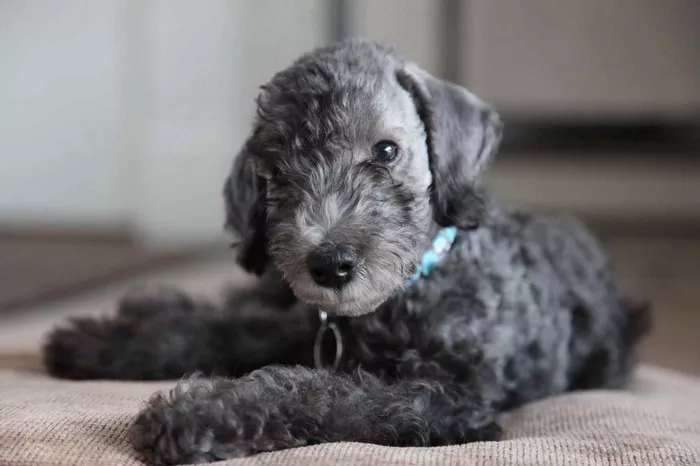The Bedlington Terrier, often called the “lamb of the dog world” due to its soft, curly coat and gentle appearance, is a breed with a rich history. Originally bred in England for hunting rodents and small game, these dogs have evolved into beloved companions known for their intelligence, agility, and affectionate nature. Their unique combination of elegance and playfulness makes them popular in both show rings and family homes. But one question many potential owners ask is: Do Bedlington Terriers enjoy cuddling? Let’s explore their personality, behavior, and the factors that influence their love for snuggling.
The Affectionate Nature of Bedlington Terriers
Bonding with Their Families
Bedlington Terriers thrive on human interaction. They are described as “outgoing,” “curious,” and deeply loyal to their families. Unlike some independent terrier breeds, Bedlingtons often seek closeness with their owners. They are known to follow their humans from room to room, eager to participate in daily activities. This strong attachment suggests they enjoy physical affection, including cuddling, as a way to strengthen their bond.
Temperament and Social Behavior
These dogs are naturally friendly and adaptable. They tend to be gentle with children and sociable with strangers, though they may act protective if they sense a threat. Their playful, “clownish” personality often translates into a love for lap time after a burst of energy. For example, after a game of fetch or a walk, many Bedlingtons will happily curl up next to their owners for a cozy nap.
Factors Influencing Their Cuddling Behavior
Genetics and Breed Traits
Bedlingtons were historically bred to work closely with humans, which may explain their people-oriented nature. Their lineage as hunting companions required them to be responsive to commands and attuned to their handlers’ emotions. This genetic predisposition toward cooperation likely contributes to their desire for physical closeness.
Early Socialization
Puppies raised in loving, interactive environments are more likely to develop a cuddly demeanor. Exposure to gentle handling, positive reinforcement, and regular human contact during their first few months shapes their comfort with affection8. Bedlington Terriers that lack this socialization might be more reserved.
Individual Personality
While the breed generally enjoys companionship, individual differences exist. Some Bedlingtons are “velcro dogs” that insist on constant contact, while others prefer brief cuddles on their own terms. Observing a dog’s body language—such as leaning into touches or nudging for attention—can clarify their preferences.
Comparing Bedlingtons to Other Breeds
Versus Independent Terriers
Many terrier breeds, like the Jack Russell or Scottish Terrier, are known for their independence. Bedlingtons, however, are notably more affectionate. Their “lap-sized” build and desire to be “part of the family” make them more inclined to snuggle than their feisty cousins.
Similarities to Companion Breeds
Bedlingtons share traits with breeds like the Cavalier King Charles Spaniel or Havanese, which are renowned for their cuddliness. Their hypoallergenic, low-shedding coats also make them ideal for close contact, as they leave less dander on furniture and clothing.
How to Encourage Cuddling
Building Trust
Start Early: Introduce gentle petting and lap time during puppyhood.
Respect Boundaries: Avoid forcing interaction if the dog seems anxious.
Positive Reinforcement: Reward calm behavior with treats or praise.
Creating a Cozy Environment
Bedlingtons are more likely to snuggle in a calm, comfortable setting. Provide soft blankets or a designated “cuddle spot” near your favorite chair. Their love for warmth might draw them to your side on chilly evenings.
Routine and Consistency
Incorporate cuddle sessions into daily routines, such as during TV time or before bed. Consistency helps them associate closeness with safety and relaxation.
Health Considerations
Physical Comfort
Bedlingtons are generally healthy, but conditions like copper toxicosis (a liver disorder common in the breed) or joint pain can affect their willingness to cuddle. Regular vet checkups ensure they remain comfortable and pain-free.
Grooming Needs
Their curly coats require trimming every 6–8 weeks to prevent matting, which can cause discomfort. A well-groomed Bedlington is more likely to enjoy prolonged physical contact.
Common Misconceptions
“They’re Too Energetic to Cuddle”
While Bedlingtons are active and playful, they balance high energy with moments of calm. Their “off switch” often emerges when they’re near their favorite humans.
“All Small Dogs Love Cuddling”
Size doesn’t always predict cuddliness. Bedlingtons’ affectionate nature stems from their temperament, not just their compact size.
Conclusion
Bedlington Terriers are natural cuddlers when raised in a loving environment. Their loyalty, intelligence, and gentle disposition make them excellent companions for those seeking an affectionate pet. By understanding their needs and respecting their individuality, owners can nurture a strong, snuggly bond with these charming “woolly” terriers. Whether lounging on the couch or joining in family activities, a Bedlington’s idea of happiness often includes being close to the people they love.
Related Topics:
WILL A BEDLINGTON TERRIER PROTECT YOU?
WHAT IS THE PURPOSE OF THE BEDLINGTON TERRIER?
ARE BEDLINGTON TERRIERS HIGH MAINTENANCE?


